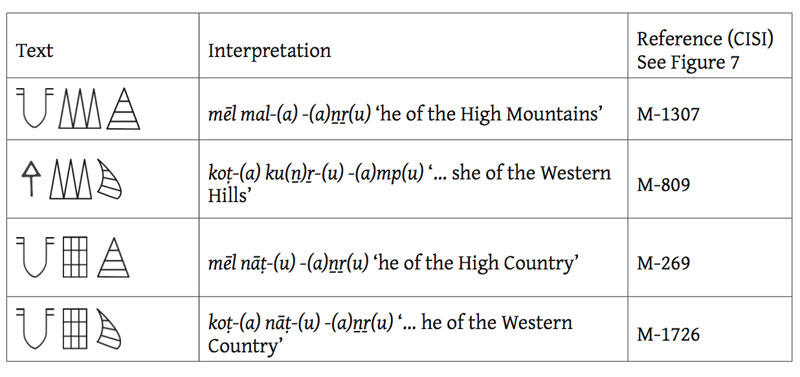This recent paper by the late Iravatham Mahadevan and his collaborator M.V. Bhaskar (in the book Walking with the Unicorn, 2018) looks at signs in the Indus script that can be related to physical features in the landscape, and how this might play out in terms of interpreting them. A number of interpretations seem to fit together nicely, particularly when one looks at the similarity in terms in Dravidian languages between 'high/west' and 'low/east': "The comparison reveals that the architecture of the Indus cities with the ‘high’ citadel in the ‘West’ and the ‘lower’ town in the ‘East’ is in conformity with the Dravidian rather than Indo-Aryan world view" write the authors.
The ideogram for mountain/hills seems the most solid, simply because something eerily similar is used in other ancient languages, and the author's later analysis at the root of the word "Himalaya" also lends support to their interpretation. The sign for plains, or 'country/province/rural tract' also seems convincing, especially as the word also has homonyms for 'guild/assembly' attested to in Tamil. From there looking at the 'high/west' 'low/east' signs also has clear merits, particularly when the authors bring in the names of tribes which one can assume played (and still do) a major role in the way people think of themselves. The 'battle axe' sign/synonym seemed less convincing, but part of the issue as one delves deeper into the material is that there are not many people who know the roots of words in Tamil and other Dravidian languages as well as Mahadevan, making it hard for the outsider to judge the probability that these interpretations are correct. They may well be, it just is that one seeks a completely convincing third-party source to support the arguments.
Nonetheless, this paper, one of his last, reminds us of why Mahadevan, who passed away last month, will be so sorely missed. Unafraid to make important and often very logical connections between Indus ideograms and Dravidian words and meanings, imbued with extensive knowledge yet also careful and persistent, his contributions to Indus script research over almost 50 years remain among the finest we have from any scholar in this field. This paper, like many of his later papers, is built upon a long history of thinking about these issues and individual signs, and together with the work of Asko Parpola, remains by far the best and most convincing work we have in the field.
Abstract
Identification of ideograms in the Indus Script depicting the physical features ‘hills’ and ‘plains’, ‘high’ and ‘low’, and the directions ‘West’ and ‘East’, is proposed in the paper. It is also shown that the ideograms, when combined as pairs in the Indus texts, correspond to specific toponyms in the Indus Realm, especially ‘high mountains’, ‘highlands’, ‘western hills’ and ‘eastern hills’. Names of tribes, also serving as place names, depicted by the ideograms are also identified. In Dravidian languages, terms for ‘high’ also denote ‘West’, and terms for ‘low’ also denote ‘East’. The Dravidian usage reveals that the architecture of the Indus cities with the ‘high’ citadel in the west and the ‘lower’ town in the east is in conformity with the Dravidian world view. The results strongly support the Dravidian authorship of the Indus Civilization. The authors acknowledge their indebtedness to the studies by R. Balakrishnan, especially to his insight that it is the Dravidian linguistic usage ‘high-west’ and ‘low-east’ that must have influenced the architecture of the Indus cities.

